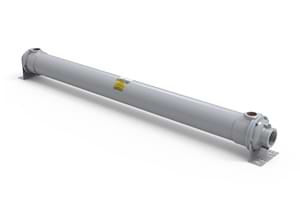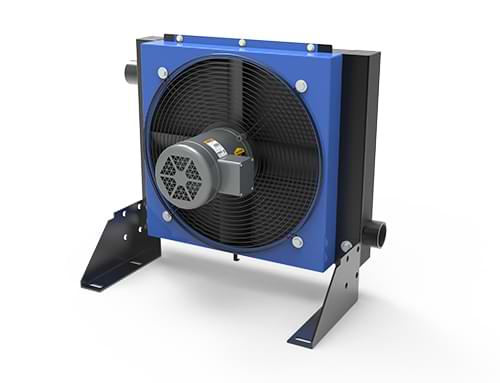Aftercoolers for Abrasives Blasting
When air is compressed, it heats up and retains moisture from the environment. If this hot, damp air enters the blasting system, it can cause abrasive material to clump, clogging nozzles and reducing efficiency. Wet air also risks corroding equipment and contaminating the blasted surface, leading to costly repairs or rework. Aftercoolers address this by cooling the compressed air, condensing moisture into liquid form, which is then removed via a separator. This ensures dry, cool air reaches the sandblaster, enhancing performance and longevity.
Applications
- Industrial Cleaning: Sandblasting is widely used to clean industrial equipment, such as boilers, tanks, and pipes, where rust or scale buildup can be detrimental.
- Restoration: In art and architecture, sandblasting can delicately remove layers of paint or grime from antiques or facades without damaging the underlying material.
- Engraving and Etching: For creating decorative patterns on glass, metal, or stone, sandblasting allows for precise control over the depth and texture of the design.
Water Cooled Aftercoolers
Compressor Cooling
- Fixed or Removable Tube Bundles
- Material Options Available
- Standard and Custom Options

Air Cooled Aftercoolers
Compressor Cooling
- Use Ambient Air to Cool
- Variety of Motor Options
- Standard Pressures of Up To 250 psi

The Process of Abrasive Blasting
The basic setup for abrasive blasting involves:
- Abrasive: This can range from sand, glass beads, steel shot, or even walnut shells, each chosen based on the desired outcome of the blasting process.
- Blasting Medium: Compressed air, water, or a combination of both can be used to accelerate the abrasive.
- Blasting Equipment: This includes a blast pot or pressure vessel where the abrasive is stored, hoses to direct the abrasive, a nozzle to control the flow, and often protective enclosures for the operator and to contain the blasting media.
Sub-Types of Abrasive Blasting
Dry Blasting
- Sandblasting: Uses silica sand but is less common now due to health concerns from silica dust.
- Shot Blasting: Utilizes metal shots like steel for peening or cleaning metal surfaces, commonly used for strengthening surfaces through compressive stress.
- Grit Blasting: Involves harder abrasives like aluminum oxide or silicon carbide for aggressive cleaning or preparation of surfaces.
Wet Blasting
- Vapor Abrasive Blasting: Combines water and abrasive for dust suppression and lower abrasive consumption.
- Slurry Blasting: A mixture of water and abrasive is used, which is gentler on surfaces and reduces dust.
The Role of Aftercoolers in Abrasive Blasting
In any compressed air system, including those used for abrasive blasting, moisture can be a significant issue. Compressed air cools as it expands through the blasting nozzle, leading to condensation which can then mix with the abrasive, reducing effectiveness or causing rust on metal surfaces. Here's where aftercoolers come into play:
- Function: Aftercoolers are heat exchangers installed downstream after the compressor. They cool down the hot compressed air, causing the moisture to condense into liquid form, which can then be removed before it reaches the blasting equipment.
- Benefits in Abrasive Blasting:
- Improved Efficiency: Dry air ensures that the abrasive acts more effectively on the target surface without interference from moisture.
- Surface Protection: Prevents rust and corrosion on the blasted surfaces and within the blasting equipment itself.
- Media Longevity: Keeps abrasives dry, extending their usable life and reducing waste.
Aftercoolers can range from simple air-cooled types to more complex refrigerated units, chosen based on the volume of air, ambient conditions, and the specific requirements of the blasting operation. By ensuring that the air used for blasting is as dry as possible, aftercoolers play a crucial role in maintaining the quality and efficiency of abrasive blasting processes.


